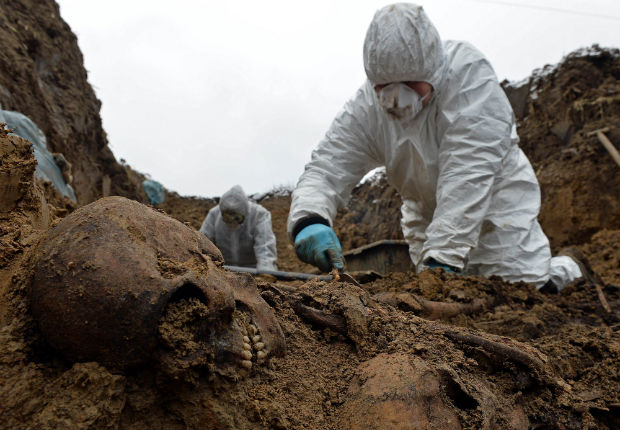Poland unearths one of WWII’s darkest secrets

An archaeologist excavates remains of one of more than 2500 Soviet and Italian soldiers from World War II who died in a Nazi German stalag near the city of Przemysl, on November 28, 2014. AFP
PRZEMYSL, Poland — Anastasia carefully digs through the earth with her trowel. Bit by bit, a human skeleton emerges, piled on top of more bones.
She removes them with care, slipping them gently into a plastic container.
Was it an Italian soldier? Or a Soviet? Identifying the bodies, while possible, is tricky.
What is known is the man died in one of numerous stalags (German prisoner-of-war camps) where Red Army and Allied troops — including Italians after Italy switched sides from the fascist camp — were interned.
The fate of the Italians who had been fighting alongside the Wehrmacht on the Eastern Front is one of the war’s many dark secrets.
Article continues after this advertisementTreated as traitors by the Nazis after Rome surrendered, thousands were shot, worked or starved to death in the camps.
Article continues after this advertisementNow, 70 years after the end of World War II, thanks to the excavations in eastern Poland, these unknown soldiers are getting a proper burial.
Wearing white flu masks and jumpsuits, the dozen crew members sort the remains: shinbones to one side; vertebrae, ribs and small bones to the other.
The skulls go elsewhere, packed in individual plastic bags.
“It’s the only way to count the exact number of victims,” archaeologist Przemyslaw Kolosowski told AFP.
He is in charge of the dig near former stalag number 327 of Przemysl-Pikulice, near the southeastern Polish city of Przemysl.
The bones have ossified over the years, making it difficult to unearth victims one by one.
In six weeks, the crew has dug up the remains of around 3,000 Italian and Soviet prisoners from eight mass graves in the area.
Italians seen as traitors
The remains are then moved to nearby Nehrybka, the site of a new military cemetery scheduled to open next year.
Already buried there are the bodies of the 1,500 victims unearthed by the Polish branch of the Red Cross in 1963.
“We don’t know why they didn’t check all the mass graves then. Maybe they didn’t have the funds,” says Adam Siwek from the Council for the Protection of Struggle and Martyrdom Sites, the state agency behind the excavations.
“Today we’re finishing up what should have been done long ago,” he said.
Most of the soldiers died of hunger or diseases brought on by the inhumane conditions in the stalag, according to Kolosowski.
The din of metal rings out from the depths of the three-metre (10-foot) hole. Anastasia, a 23-year-old museology student from the western Ukrainian city of Lutsk, has unearthed a tablespoon.
Crudely etched into it is the camp arrival date: 30 IX 41 g. The date and the g for “god” — or year in Russian — show that the spoon belonged to one of the Soviet soldiers imprisoned after the Nazis attacked the USSR on June 22, 1941.
“Personal items are extremely rare,” says archeology student Mariusz Dziekonski.
“The Germans buried most of the soldiers without any clothes.”
He points to a couple of small Orthodox crosses, a toothbrush, part of a Soviet-made comb, a few buttons and kopecks (Russian coins), plus the most precious objects: Italian and Soviet dog tags — all but illegible.
For now, only two names have been deciphered: those of Red Army soldiers Chernienko (no first name) and Vasily Bunko.
The Italian troops arrived at the stalag in 1943, after Nazi Germany’s ally, Italian fascist dictator Benito Mussolini, was deposed.
He had sent around 230,000 soldiers to the Eastern Front to fight alongside the Germans.
“The soldiers who refused to keep fighting for Hitler were sent to camps, where they suffered particularly cruel treatment at the hands of their former allies, who saw them as traitors,” Kolosowski said.
Farmer Stanislaw Hanczuk was surprised to learn of the mass grave in his field.
“For years, we worked the land and planted wheat. Now it turns out we were doing it on buried bodies. Who could have known?” he asked.
“At last we’ll be able to live in peace and won’t be asking ourselves whether any bodies are still down there.”
But 85-year-old villager Tadeusz Lelek is not convinced: “What’s the use?” he said.
“We should just let them rest in peace, right where they are.”
RELATED STORIES